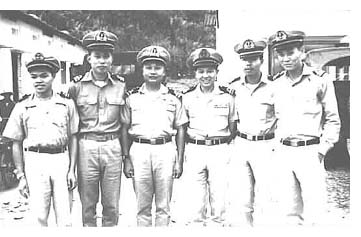North Vietnam 1961-68

South Vietnamese maritime raiding crew
For over a decade, the U.S. carried out a series of paramilitary exile raids against North Vietnam . The program began as a French-led guerrilla force to operate behind communist lines during their war against the Viet Minh; toward the end, the CIA began liaison efforts with the French, a role which by mutual consent was expanded following the Geneva Accords of 1954. Sabotage efforts continued for another year or so, with the Vietnamese commandos gradually being converted into a standing force equipped and trained by the CIA. Low-level infiltration missions for intelligence purposes were also carried out, again under the aegis of the CIA. When the insurgency in South Vietnam began in the late 1950s, the idea immediately arose – from CIA officials in Saigon and others connected with the agency – of combining the two programs so as to revive the earlier sabotage raids. This policy was strongly backed by Kennedy within a week after he took office, and the CIA began to gear up a commando program. Predictably, the operations were unsuccessful; and so, predictably, the next move was to expand the program, first, by taking it away from the CIA and giving it to the military; and second, by transforming it into a large-scale program aimed at “direct pressures ... upon North Vietnam ... based on the premise that by covert means the North Vietnamese would be warned that their support of the Viet Cong insurgents was about to bring down direct punishment.” Within a few months, however, even as the raids were being stepped up, U.S. policy makers began casting around for stronger and more damaging means of signaling to Hanoi ; this would eventually become the Rolling Thunder bombing campaign (see chapter six of the book and this website). Nonetheless, the raids did not end and for the next several years became simply one of the various U.S. tactics in its anti-North Vietnam efforts. In the autumn of 1968, without any apparent discussion of the raids themselves, Johnson authorized language (“cessation of bombing and all other acts involving the use of force against the territory” of North Vietnam ) which ended the program in exchange for four-party peace talks. Even this was not the coup de grace and the Pentagon kept the commandos in readiness for several more years, in hopes that maritime missions would once more be authorized. 1
1) Krulak, “Report on the Visit of the Secretary of Defense to South Vietnam , 19-20 December 1963,” 21 December 1963, FRUS 1961-1963 , vol. 4: doc. 372; also docs. 331, 347, 360, 373-4; State to Harriman and Vance, 14 October 1968, FRUS 1964-1968 , vol. 7: doc. 65; also doc. 48; FRUS 1961-1963 , vol. 1: docs. 3-4, 16 [this is the formal order on training], 42 [pt. II.d.6], 52; NSAM 28, “Guerrilla Operations in Viet-Minh Territory ,” 9 March 1961 (John F. Kennedy Library 2006); Pentagon Papers (1971: vol. 2, doc. 100); FRUS 1964-1968 , vol. 1: docs. 4, 13, 16, 26, 57, 66, 68, 77, 84, 90, 101; Shultz (1999); Conboy and Andradé (2000: 226-63); Prados (2003: 63-5, 74-82, 135-40, 351nn20-1). The CIA did run sabotage missions into areas of North Vietnam bordering on Laos after 1968, but these do not seem to have involved Vietnamese commandos.
